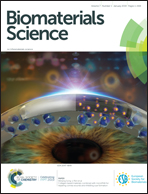A hepatitis B virus-derived human hepatic cell-specific heparin-binding peptide: identification and application to a drug delivery system†
Abstract
Viruses are naturally evolved nanocarriers that can evade host immune systems, attach specifically to the surfaces of target cells, enter the cells through endocytosis, escape from endosomes efficiently, and then transfer their genomes to host cells. Hepatitis B virus (HBV) is a ∼42 nm enveloped DNA virus that can specifically infect human hepatic cells. To utilize the HBV-derived early infection machinery in synthetic nanocarriers, the human hepatic cell-binding site (i.e., the sodium taurocholate co-transporting polypeptide (NTCP)-binding site, with myristoylated pre-S1(2–47)) and the low pH-dependent fusogenic domain (pre-S1(9–24)) are indispensable for targeting and endosomal escape, respectively. However, cell-surface NTCP has recently been shown not to be involved in the initial attachment of HBV. In this study, we identified a novel heparin-binding site (pre-S1(30–42)) in the N-terminal half of the pre-S1 region, which presumably interacts with cell-surface heparan sulfate proteoglycan (HSPG) and plays a pivotal role in the initial attachment of HBV to human hepatic cells. The evolutionarily conserved amino acid residues Asp-31, Trp-32, and Asp-33 are indispensable for the heparin-binding activity. Liposomes (LPs) displaying the peptide were endocytosed by human hepatic cells in a cell-surface heparin-dependent manner and delivered doxorubicin to human hepatic cells more efficiently than myristoylated pre-S1(2–47)-displaying LPs. These results demonstrated that the pre-S1(30–42) peptide is the most promising HBV-derived targeting peptide for synthetic nanocarriers, and that this peptide exhibits high specificity for human hepatic cells and efficiently induces endocytosis.



 Please wait while we load your content...
Please wait while we load your content...